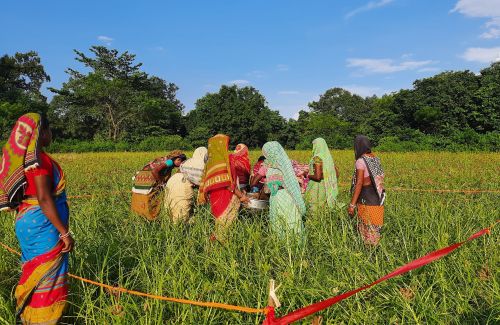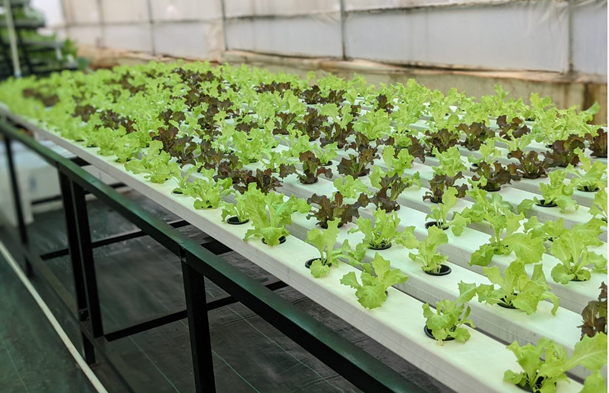Ranchi is often referred to as the tribal city. It became the capital of the state of Jharkhand, when it was carved out from the Adivasi areas of the Chhotanagpur plateau and the Santhal Parganas of southern Bihar. While its initial growth in the 1950s was triggered by the establishment of the Heavy Engineering Corporation Ltd. (HECL) that displaced 23 Adivasi villages, the city as it expanded engulfed several other tribal villages that continue to exist within and alongside it. Within formal planning and governance frameworks, many of these are classified as informal settlements.
The informal settlements in Ranchi are distinct. Unlike other typical mid-sized Indian cities bursting at their seams, in Ranchi the inhabitants of the informal settlements enjoy a certain degree of tenure security. Legally, tribal communities in India cannot be alienated from their lands. Hence the many slums of Ranchi continue to be inhabited by the original tribal inhabitants – some of them are fourth or fifth generation inhabitants.
In the recent past, Ranchi has been in the news for its 'water wars'. The city is located alongside the Subarnarekha and South Koel rivers and their tributaries. Historically, the rivers have provided the water requirements of the city and its numerous tribal hamlets, and also shaped the livelihoods and everyday practices of its inhabitants. Till date, the Subarnarekha is Ranchi's main source of water, although unfettered urbanisation has not just polluted this source of water, but has triggered a downward spiral of diminishing ground water and drying up surface water.
 The worst hit in the city's water wars are its slums, scattered throughout Ranchi (see map). These geographical markers of inequity are usually the last to be connected to basic services, water included, since they have the least priority within formal planning and governance mechanisms. And for the tribal residents of these slums, even as rapid urbanisation severed and disrupted ecological relationships and their attendant livelihoods and day-to-day practices, enhancing water resilience emerged as an imperative. Community wells in the settlements dried up and or got polluted. Reactionary deep bores proved temporary solutions and piped water supply seemed a distant dream.
The worst hit in the city's water wars are its slums, scattered throughout Ranchi (see map). These geographical markers of inequity are usually the last to be connected to basic services, water included, since they have the least priority within formal planning and governance mechanisms. And for the tribal residents of these slums, even as rapid urbanisation severed and disrupted ecological relationships and their attendant livelihoods and day-to-day practices, enhancing water resilience emerged as an imperative. Community wells in the settlements dried up and or got polluted. Reactionary deep bores proved temporary solutions and piped water supply seemed a distant dream.
The communities responded by leveraging their own traditional practices and associated knowledge. On one hand, community-shared water infrastructure – mainly wells – had been in use until a couple of years ago. On the other, the experience and knowledge of water usage from community wells remains etched in communities as does the associated social capital. These hooks together constituted a circumstance for collaboration while providing a platform and a direction for enabling decentralised water resilience interventions.
The intervention, to begin with sought to create an ecosystem of critical and relevant stakeholders and associated skills. In effect, this required a collaboration between communities, local non-profits such as the Mahila Housing Trust (MHT), a non-governmental organisation with a long-standing presence in the slums, and the municipal councillors. While the communities brought in the embedded ecological knowledge and lived experience, MHT played the crucial role of forging a technical partnership with the right design inputs, and also mobilising communities through Community Action Groups (CAGs) and community anchors referred to as Vikasinis. These alliances proved valuable in leveraging complementary capacities to enable the much-required synergy within the eco-system.
 Broadly, the intervention sought to revive and repair community wells and institute grey water management processes. Both of these relied on passive technologies that communities were familiar with, as against engineered solutions. The initial phase was to understand the specific local context. This involved a systemic understanding of the water problem at the city and the city-region scale, and its manifestation at the settlement scale. The location of the informal settlement within the city and in relation to the river and the embedded relationships were understood. This was critical to move from a 'one size fit all' solution to context-specific solutions.
Broadly, the intervention sought to revive and repair community wells and institute grey water management processes. Both of these relied on passive technologies that communities were familiar with, as against engineered solutions. The initial phase was to understand the specific local context. This involved a systemic understanding of the water problem at the city and the city-region scale, and its manifestation at the settlement scale. The location of the informal settlement within the city and in relation to the river and the embedded relationships were understood. This was critical to move from a 'one size fit all' solution to context-specific solutions.
A combination of technical and social criteria such as settlement size, location, number of wells, existing social capital and community engagement led to the shortlisting of the 60-year-old Bada Ghaghra settlement with its 2000 households and traditional water resource management structures as the optimal location for demonstrative implementation. Within the settlement a collaborative community-centered exercise enabled through several rounds of conversations led, as a first step, to the framing of specific challenges of water access and security.

After this, possible solutions needed to be discussed and agreed. This involved identifying specific stakeholders and understanding challenges and requirements. Multiple stakeholder meetings focusing on a shift from discussing individual interests to shared benefits were organised. Dialogues took place with and through community members, oriented towards discussing trade-offs between interests, benefits and capacities of various stakeholder. These were critical to arrive at workable solutions, premised on an overlay of technical and social factors.
To illustrate, after some wells had been selected by examining technical feasibility such as water quality, clearance, location, etc. a few of them had to be discarded because of social factors such as ownership status, access and usage and perceptions of water quality amongst others. Eventually, community ownership was prioritised over private ownership, and social feasibility was valued equally if not more than technical feasibility.
Once the suitable wells were identified, discussion and negotiations between MHT workers, CAGs and Vikasinis and those living around the identified wells on the recharge methods and the maintenance of these as community resources took place . Not everyone consented to this, however. The owners of some wells declined to participate, and denied permission for their wells to be used by others. Other wells were then identified, and another round of engagement and negotiations with those around the new wells were carried out. This went on until all the wells needed for the overall community plan were selected.
In this process, a number of concerns raised by users and other residents around each well also came to the fore, and had to be addressed. Most wells, as well as the areas around them, were in use by several families in different ways, and they were concerned that their activity should not be interrupted. At the same time it was also important to ensure that their activities did not end up harming the health or use of the well after it was revived. Consultations and negotiations were key to anticipating and averting this (see illustrations below). Similar conversations and negotiations took place around the grey water management intervention.

Illustration: Typical concerns and problems around a selected well.
Solutions were then identified through consultations and negotiations.

The strategies and steps that were eventually agreed needed to be codified and formalized in some way. A non-financial Memorandum of Understanding (MoU) was agreed between the community, the councillor and MHT, formalising roles and responsibilities and signalling a commitment to the interventions. Similarly, bank accounts were operationalised to enable ongoing maintenance of the wells. Finally, resources such as finances, labour, material and land were identified and mobilized, where possible from within the community. On the basis of this formalisation, work began to recharge wells, and to improve grey water management.
The intervention was supported by household surveys - on water and sanitation usage patterns and habits, and also by mapping the wells and monitoring the quantity and quality of water. This was done not only in the intervention wells, but all wells within a 500 meter radius of the intervention wells. This helped to understand the impact of the intervention.
Revived and repaired wells were also to be handed over to the community, and as a result it was important that residents knew their responsibilities for stewardship of the wells after the work was completed. Awareness campaigns led largely by the Community Action Groups and the vikasinis on the do's and dont's of well usage and grey water management were undertaken. People were educated about the terms of the MoU. Information campaigns were also carried out, typically by putting up signages and distributing pamphlets, to inform and reinforce messages and roles. Such awareness was particularly important, because money had to be collected regularly to maintain the wells too.
 |
Finally, to sustain and scale up this demonstrative exercise, a handbook was prepared. The processes employed, the challenges encountered, and the instruments used to operationalise the intervention are all documented in the handbook (click here to download). The aim of this handbook is not to replicate solutions but to scale-up and carry forward process principles that will aid in instituting optimal solutions across the other 75-odd informal settlements that MHT works in. The intervention in Bada Ghaghra, unlike in other urban poverty projects, emphasises processes as well as the adaptation to social considerations.
These could well be the key to its success, and also offer the best hope that other places too can be similarly transformed. India's burgeoning towns and cities require re-imagined alternatives to the dominant Master Planning exercises. Alternatives that emphasize decentralised, collaborative and participative methods, and which also lead to resilience, are urgently needed. In this regard, the experience of Bada Gaghra is demonstrative, if not transformative. It contrasts and contests the top-down, expert-driven, control-based institutionalized planning that is now the norm in our cities with collaboratively designed decentralised processes premised on the lived experience and embedded knowledge systems of communities.



























